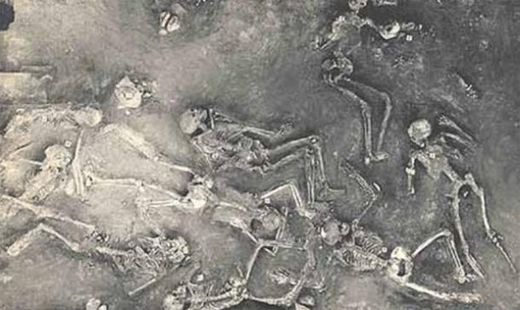
Charged with all the power of the Universe.
An incandescent column of smoke and flame
As bright as the thousand suns
Rose in all its splendor...
...it was an unknown weapon,
An iron thunderbolt,
A gigantic messenger of death,
Which reduced to ashes
The entire race of the Vrishnis and the Andhakas.
-Mahabharata, Indian Epic
However, in contrast to the well-appointed houses and clean streets, the uppermost levels at Mohenjo Daro contained squalid makeshift dwellings, a careless intermingling of residential and industrial activity and, most significantly, a series of more than 40 sprawled skeletons lying scattered in streets and houses. Paul Bahn (2002) describes the scene:
In a room with a public well in one area of the city were found the skeletons of two individuals who appeared desperately to have been using their last scraps of energy to crawl up the stair leading from the room to the street; the tumbled remains of two others lay nearby. Elsewhere in the area the 'strangely contorted' and incomplete remains of nine individuals were found, possibly thrown into a rough pit. In a lane between two houses in another area, another six skeletons were loosely covered with earth.Numerous other skeletons were found within layers of rubble, ash and debris, or lying in streets in contorted positions that suggested the agonies of violent death.











Comment: For more clues see Electric Universe: Mohenjo Daro and Laura Knight-Jadczy's Comets and the Horns of Moses (The Secret History of the World)